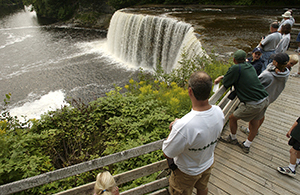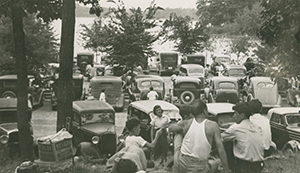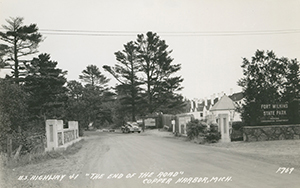This is part of a series of stories to mark the centennial of Michigan state parks. On May 12, 1919, the Michigan Legislature established the Michigan State Park Commission, paving the way for our state parks system. The Michigan Department of Natural Resources is celebrating this milestone throughout the year with special events, podcasts, historical stories, videos, geocaching and more. Find more details at Michigan.gov/StateParks100.
By CASEY WARNER
Michigan Department of Natural Resources
|
 Visit a popular destination like Grand Haven State Park or Tahquamenon Falls State Park on a sunny summer day, with their bustling parking lots and vehicles lined up at the entry gates, and the link between cars and state parks is evident. Visit a popular destination like Grand Haven State Park or Tahquamenon Falls State Park on a sunny summer day, with their bustling parking lots and vehicles lined up at the entry gates, and the link between cars and state parks is evident.
That connection began decades ago, as the burgeoning automobile industry drove development of Michigan’s state park system.
That system dates back to 1919, with the establishment of the Michigan State Park Commission and Interlochen State Park.
During this same era, cars were becoming an increasingly popular mode of transportation.
“The turn of the century marked the start of the motor age and the beginning of a revolution in transportation. Ready access to features of the State would no longer be limited to points on railroads or water routes,” the Michigan Department of Conservation’s “State Parks of Michigan: A Report of the Past, a Look to the Future,” said in 1957. |
|
 The auto industry’s growth was an important trend for park development nationwide as well as in Michigan. The auto industry’s growth was an important trend for park development nationwide as well as in Michigan.
By the time the National Park Service was formed in 1916, “motor cars, many mass produced by Michigan technology, were speeding tourists along an expanding network of roads,” Claire V. Korn wrote in the book “Michigan State Parks: Yesterday Through Tomorrow.”
In 1921, when the first National Conference on State Parks convened, Michigan was one of only 17 states that had its own state parks.
“Michigan’s state park system was built on the foundations painstakingly laid at this conference. Before dispersing, the conservationists issued a call for all governments – local, county, state, and national – to acquire recreational lands and waters within easy access of all citizens,” Korn wrote.
The mindset of making outdoor recreation opportunities accessible to travelers was evident on state road maps.
In 1912, Michigan’s highway department issued a free road map of the state. In 1919, the state Legislature authorized the highway department to publish and sell a tourist map. By 1922, that map included state parks, and by 1923 the map also contained information on recreation sites, campsites and ferry schedules. |
|
 In 1919, Michigan also established the nation’s first roadside park, along US-2 in the Upper Peninsula’s Iron County, a development spurred by Iron County Road Commission engineer Herbert Larson’s difficulty in finding a picnic spot while on a vacation to northern Wisconsin. In 1919, Michigan also established the nation’s first roadside park, along US-2 in the Upper Peninsula’s Iron County, a development spurred by Iron County Road Commission engineer Herbert Larson’s difficulty in finding a picnic spot while on a vacation to northern Wisconsin.
Access to outdoor recreation became a selling point for both Michigan tourism – with the State Park Commission adopting the slogan “Michigan – America’s Playground” – and cars.
An advertisement for the 1924 Ford Model T, showing a family camping on the lakeshore, said “Get out the old fish pole, the lunch basket, your camping outfit and camera – you’ll need them now that Spring is here again. Neither stream, nor field, nor mountain park can hide their beauty from you – it’s all yours with a Ford.”
With the state’s roads carrying an increasing number of tourists in search of the great outdoors, Michigan also built the nation’s first permanent travel information center at New Buffalo, in the southwest corner of the state near the Indiana border, in 1935.
The expansion of the auto industry in the early 1900s also meant ample job opportunities in Michigan.
“‘Michigan Leads All States in Gain of People in Towns!’ a 1921 newspaper headline trumpeted, and Detroit was bursting its seams.
“The sons of poor struggling farmers, lumberjacks, and miners were flocking to the city to take lucrative and dependable factory jobs. Steady work brought prosperity, and with prosperity came leisure … for the common working family,” Korn wrote. |
|
 “At last all the pieces – the idea, the means, the need, the transportation, and the organization – united to fuel the vigorous growth of Michigan’s state park system.” “At last all the pieces – the idea, the means, the need, the transportation, and the organization – united to fuel the vigorous growth of Michigan’s state park system.”
The Michigan Department of Conservation, in its 1923/1924 biennial report, noted the need to expand parks to keep up with the increase in cars, roads and leisure time:
“The ever increasing number of automobiles, the extension of good roads, together with an increase of efficiency in production which makes available more time for the people to use both the automobile and road – all go to make up the problems of taking care of the increased number of people who are travelling.
The work that is being done and effort spent to cope with other problems caused by the same three factors, is proof enough to show them a great big reality. Questions that arise on this are: Where are they all going? Where should they go? What shall they do when they get there? An adequate system of State Parks will do much towards the solution or answers to these points.”
The report’s recommendations included acquiring more lands in southern Michigan for state parks, enlarging and improving existing park sites, and helping local governments establish parks.
In 1922, the first year park attendance was recorded, state parks welcomed more than 200,000 visitors. By 1930 – eight years later, by which time 30-plus state parks had been established – attendance had skyrocketed to more than 8 million visitors a year, a 40-fold increase.
And by 1955, when another 20 parks had been added to the system, annual state park attendance had grown to almost 18 million.
See a list of dates Michigan state parks were established.
Today, Michigan’s 103 state parks see 28 million visitors a year.
Learn more about Michigan’s state parks at Michigan.gov/StateParks. |
Check out previous Showcasing the DNR stories in our archive at Michigan.gov/DNRStories. To subscribe to upcoming Showcasing articles, sign up for free email delivery at Michigan.gov/DNR.
/Note to editors: Contact: John Pepin, Showcasing the DNR series editor, 906-226-1352. Accompanying photos and a text-only version of this story are available below for download. Caption information follows. Credit Michigan Department of Natural Resources, unless otherwise noted.
Text-only version of this story.
Ad: A brochure for the 1924 Ford Model T touts the car as a means to outdoor family fun. (From the collections of The Henry Ford.)
Dodge #4 1 and Dodge #4 2: Dodge #4 State Park in Oakland County – whose land was donated to state by the Dodge Brothers Corporation in 1922 – has long been a popular outdoor recreation opportunity within a short drive from urban areas. The historic photo, taken in 1940, shows a line of cars waiting to get into the park. (Dodge #4 1 courtesy of Archives of Michigan.)
Fort Wilkins 1, Fort Wilkins 2 and Copper Harbor: As cars became a more prevalent mode of travel and Michigan’s network of roads expanded, tourists could more easily visit remote outdoor attractions like Fort Wilkins State Park and Copper Harbor Lighthouse, located at the tip of the Keweenaw Peninsula. (Fort Wilkins 1 and Fort Wilkins 2 courtesy of Archives of Michigan.)
Grand Haven 1 and Grand Haven 2: Today and decades ago, Grand Haven State Park in Ottawa County is a favorite recreation destination for those traveling by car.
Island Lake: This 1938 photo shows a full parking lot at Island Lake Recreation Area in Livingston County. (Courtesy of Archives of Michigan.)
Tahquamenon Falls 1 and Tahquamenon Falls 2: The advent of auto travel enabled Michigan residents and visitors to enjoy more of Michigan’s scenic locations, like Tahquamenon Falls State Park in the eastern Upper Peninsula. Today tourists flock to these popular destinations that are just a car ride away./




 Visit a popular destination like Grand Haven State Park or Tahquamenon Falls State Park on a sunny summer day, with their bustling parking lots and vehicles lined up at the entry gates, and the link between cars and state parks is evident.
Visit a popular destination like Grand Haven State Park or Tahquamenon Falls State Park on a sunny summer day, with their bustling parking lots and vehicles lined up at the entry gates, and the link between cars and state parks is evident. The auto industry’s growth was an important trend for park development nationwide as well as in Michigan.
The auto industry’s growth was an important trend for park development nationwide as well as in Michigan. In 1919, Michigan also established the nation’s first roadside park, along US-2 in the Upper Peninsula’s Iron County, a development spurred by Iron County Road Commission engineer Herbert Larson’s difficulty in finding a picnic spot while on a vacation to northern Wisconsin.
In 1919, Michigan also established the nation’s first roadside park, along US-2 in the Upper Peninsula’s Iron County, a development spurred by Iron County Road Commission engineer Herbert Larson’s difficulty in finding a picnic spot while on a vacation to northern Wisconsin. “At last all the pieces – the idea, the means, the need, the transportation, and the organization – united to fuel the vigorous growth of Michigan’s state park system.”
“At last all the pieces – the idea, the means, the need, the transportation, and the organization – united to fuel the vigorous growth of Michigan’s state park system.”

